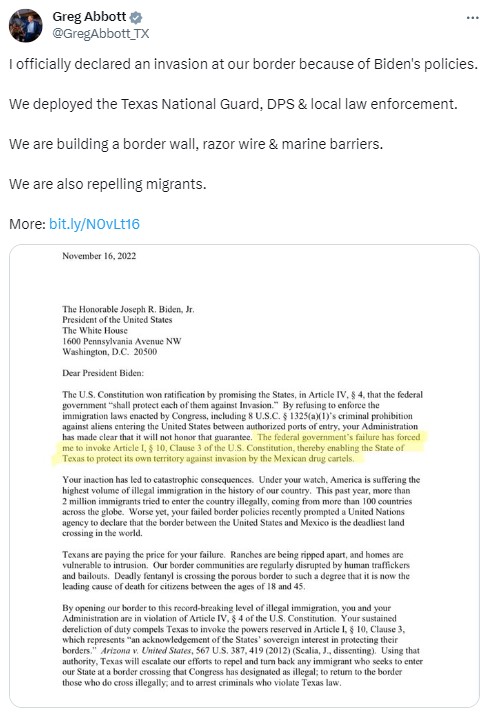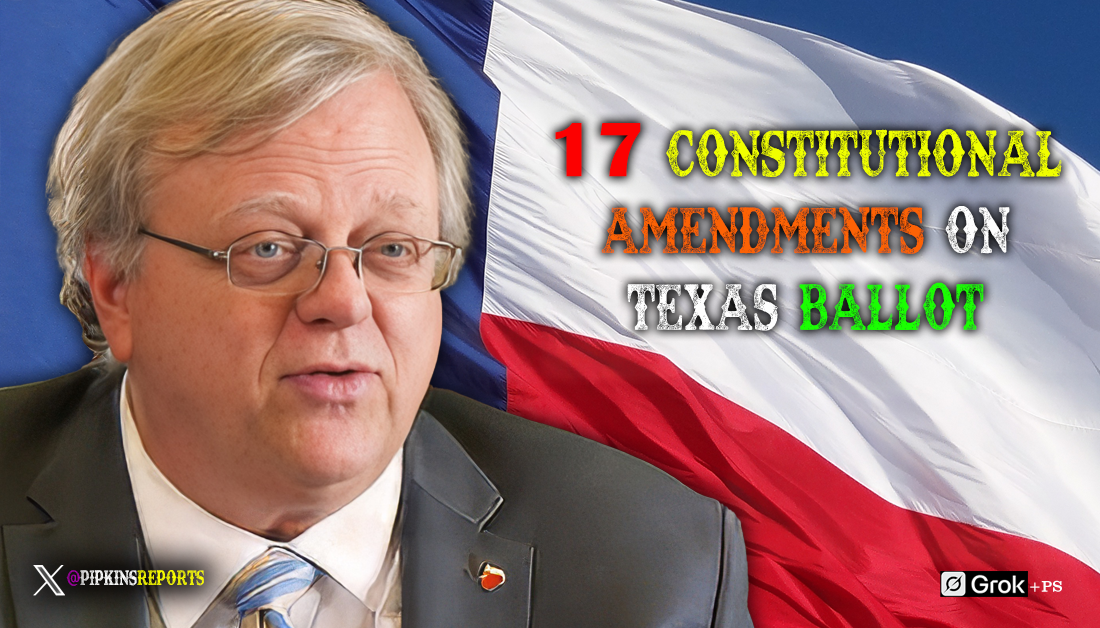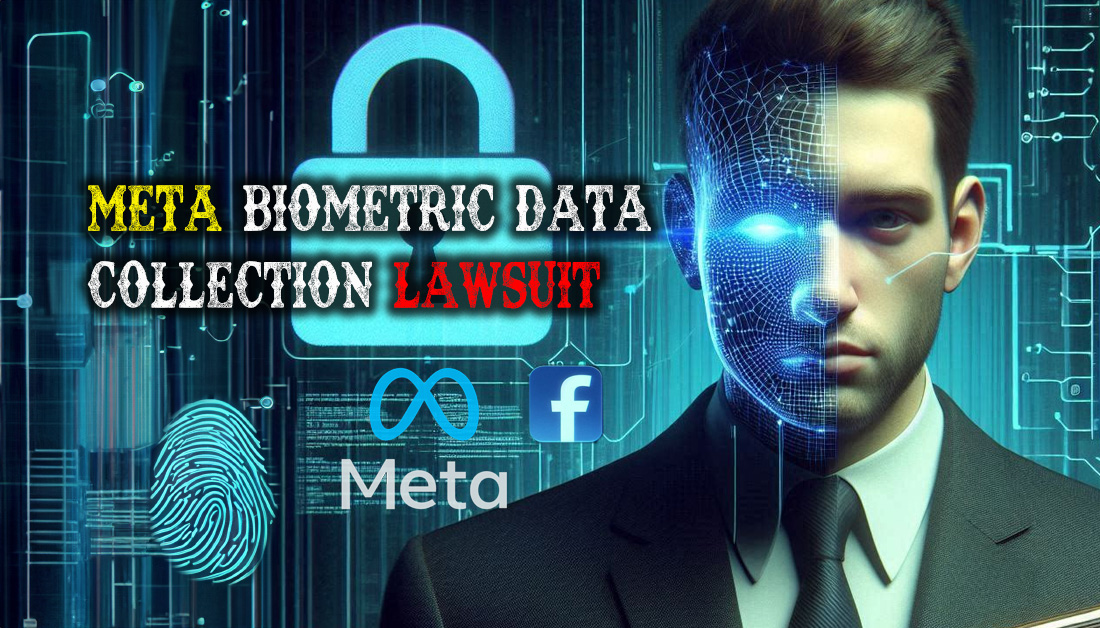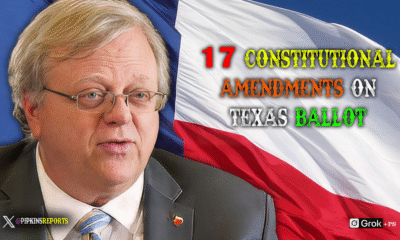Texas News
Border Hoax Exposed: Abbott’s So-Called ‘Official Declaration’

Governor Greg Abbott has NOT “Officially Declared” an Invasion at the border.
A recent social media post by Texas Governor Greg Abbott sparked controversy and claims of deception, as the Governor proclaimed to have “officially declared an invasion at our border” on September 20, 2023. Governor Abbott’s statement raised eyebrows and ignited debate. But was it truthful?

In the social media post, Governor Abbott stated, “I officially declared an invasion at our border because of Biden’s policies. We deployed the Texas National Guard, DPS & local law enforcement. We are building a border wall, razor wire & marine barriers. We are also repelling migrants.” However, a closer examination of the facts reveals a lack of clarity and transparency in the Governor’s claims.
The heart of the controversy lies in the absence of an actual “declaration” of invasion. While many media outlets reported on Abbott’s statement, few bothered to scrutinize the timeline and documents associated with the Governor’s assertions (TLJ included). Following that, a comprehensive investigation by the Texas Liberty Journal has shed light on the matter, revealing that no official “declaration” exists in the sense described by Governor Abbott.
Every official document issued by the Governor falls under either an “Executive Order” or a “Proclamation.” The closest thing to an “official declaration of invasion” dates back to July 7, 2022, when Governor Abbott issued Executive Order EO-GA-41. In this order, the Governor authorized the Texas National Guard and the Texas Department of Public Safety to respond to illegal immigration by apprehending immigrants who crossed the border between ports of entry. This executive order contains no mention of an “invasion declaration.”
Furthermore, the executive order clearly stipulates, “This executive order may also be amended by proclamation of the governor.” However, no such proclamation has ever followed, raising questions about the Governor’s commitment to the declaration’s validity.
There was a proclamation issued on May 31, 2021, declaring a “disaster” at the border, and it has been renewed every month, as mandated by the Texas Constitution. Nevertheless, this proclamation does not constitute an “invasion declaration,” as the Governor’s recent social media post suggests.
In his letter to President Joe Biden dated November 16, 2022, Governor Abbott used the term “invoke” in reference to Article I, Section 10, Clause 3 of the United States Constitution, asserting the states’ right to protect themselves if the federal government fails to protect them from invasion. However, the term “invoke” is not a legal term and holds no legislative or governmental significance without backing from either a proclamation or an executive order. It is by either of these two methods that something is truely, “invoked”, or put into action.
The crux of the matter is that Governor Abbott’s claim of having “officially declared an invasion” appears to be, at best, a misrepresentation of his earlier executive order and, at worst, a deliberate deception to mislead the public. Such a significant declaration should be backed by transparent, legally binding documents, rather than vague references to strongly worded letters.
Operation Lone Star: Transparency and Accountability Questions Linger
Amid the ongoing border challenges, Operation Lone Star (OLS) remains a cornerstone of Texas’ approach to securing its southern border. OLS, operating under the banner of Executive Order EO-GA-41, was introduced to address the multifaceted issues of illegal immigration, the illegal drug trade, and human smuggling. However, concerns about transparency and accountability surround the operation, casting a shadow on its claimed success.
Governor Greg Abbott’s vision for Operation Lone Star, as laid out in the Executive Order, has been a costly endeavor. As of April 2022, the operation was expending approximately $2.5 million per week, with an estimated annual cost of $2 billion. While these expenses underscore the state’s commitment to border security, they raise questions about the efficiency and accountability of this vast undertaking.
At its zenith, Operation Lone Star mobilized approximately 10,000 National Guard members, providing critical support to the border region. By November 2022, this number had reduced to around 6,000. The Texas Liberty Journal was unable to get an exact count of the current number of troops that are deployed.
The reported results of Operation Lone Star are undeniably impressive. The operation is said to have led to 394,200 migrant apprehensions, 31,300 criminal arrests, including 29,100 felony charges, and the seizure of a staggering 422 million doses of fentanyl…according the governor’s office. However, questions regarding the fate of the apprehended individuals remain unanswered.
One of the critical concerns is the lack of transparency regarding the fate of migrants once they are apprehended. The State has been silent on whether individuals are genuinely returned to the point of entry or if they are simply processed and released, potentially being bussed to Democrat run “Sancturary Cities”, which is a good thing. However, this glaring lack of clarity undermines the transparency of OLS and raises questions about its true effectiveness in addressing border issues. Not a single image or video of illegal aliens being returned to a point of entry has been released. In the ongoing war of public opinion, and with an effort to dissuade individuals from crossing the border illegally, one would think such an image would be a powerful tool … if it existed.
As Texas confronts ongoing border challenges, Operation Lone Star serves as a symbol of the State’s commitment to security. Yet, its enormous costs and the absence of clear information regarding the treatment and outcomes of those apprehended highlight the need for greater transparency and accountability in the operation’s execution. With these concerns in mind, it is essential that Texas residents receive detailed answers about the operation’s outcomes and expenses to assess whether it genuinely serves their best interests.
Election
Texans to Vote on 17 Constitutional Amendments, with Historic Homestead Exemption in Spotlight

AUSTIN, TX — On November 4, Texas voters will face a marathon ballot featuring 17 proposed amendments to the state’s constitution, a document that has seen over 500 revisions since 1876. Secretary of State Jane Nelson, who oversaw the ballot order draw, urged Texans to seize this chance to “make your voice heard about the governing document of our state.” From tax relief to judicial reform, these propositions reflect a conservative vision of limited government, economic liberty, and state sovereignty. But one measure, Proposition 13, stands out as a landmark effort to deliver substantial property tax relief to homeowners—a cornerstone issue for Texans grappling with rising costs in a state without an income tax.
Proposition 13: A Game-Changer for Homeowners
At the heart of this constitutional lineup is Proposition 13 (SJR 2), which would raise the homestead exemption for school district property taxes from $100,000 to $140,000, with an even higher $150,000 exemption for seniors and disabled homeowners. Paired with a tax rate compression in Senate Bill 1, this measure promises an average savings of $496.57 for homeowners, according to Sen. Paul Bettencourt (R-Houston), the bill’s author. In a unanimous vote, the Texas Senate signaled its commitment to easing the property tax burden, a perennial concern for Texans facing skyrocketing appraisals.
For many, Proposition 13 is a lifeline. Bettencourt noted that 80 to 90% of Texas seniors could pay zero school district property taxes under this plan, as would average homeowners in 49% of Texas school districts where home values fall below $140,000. This is no small feat in a state where property taxes fund much of public education. To address concerns about local revenue losses, Bettencourt emphasized that the state would reimburse school districts, ensuring they remain fully funded. “Today, the Texas Senate delivered a win for homeowners statewide,” he declared, framing the measure as a victory for taxpayers without sacrificing educational quality.
Yet, some lawmakers raised red flags during Senate debates, warning that local taxing entities—cities, counties, and special districts—might offset these savings by raising their own rates. This tension underscores a broader challenge: balancing tax relief with the fiscal needs of local governments. For constitutional conservatives, Proposition 13 embodies the principle that government should prioritize returning money to citizens, but voters must weigh whether the state’s reimbursement plan can prevent local tax hikes that could erode the promised relief.
A Broader Conservative Agenda
While Proposition 13 takes center stage, the remaining 16 amendments advance a robust conservative agenda. Proposition 2 (SJR 18) bans taxes on capital gains—realized or unrealized—protecting wealth creation from state overreach. Proposition 6 (HJR 4) shields securities transactions from occupational or transactional taxes, bolstering financial markets. Proposition 8 (HJR 2) prohibits death taxes on estates or inheritances, ensuring families keep more of their legacy.
Other tax relief measures include Proposition 5 (HJR 99), exempting animal feed held for retail from ad valorem taxes, and Proposition 9 (HJR 1), which extends similar exemptions to income-producing personal property. Proposition 7 (HJR 133) offers tax breaks for surviving spouses of veterans with presumed service-connected conditions, while Proposition 10 (SJR 84) provides temporary exemptions for homestead improvements destroyed by fire. Proposition 11 (SJR 85) further boosts exemptions for elderly and disabled homeowners, complementing Proposition 13’s focus on homestead relief.
Infrastructure and education also feature prominently. Proposition 1 (SJR 59) creates a permanent fund for the Texas State Technical College System, supporting trade programs vital to Texas’ economy. Proposition 4 (HJR 7) dedicates sales tax revenue to the Texas Water Fund, addressing water scarcity in a growing state. Proposition 14 (SJR 3) establishes a $3 billion Dementia Prevention and Research Institute, though its hefty price tag raises questions about fiscal priorities.
Safety, Sovereignty, and Civic Values
Public safety and border security are addressed in Proposition 3 (SJR 5), which mandates bail denial for certain felony offenses, and Proposition 17 (HJR 34), which offers tax exemptions for border security infrastructure in counties along the U.S.-Mexico border. Both align with conservative priorities of law and order and state sovereignty, though the latter’s vague definition of “infrastructure” warrants scrutiny.
Cultural and civic concerns shine through in Proposition 15 (SJR 34), affirming parents as the primary decision-makers for their children—a rebuke to institutional overreach in schools and healthcare. Proposition 16 (SJR 37) clarifies that only U.S. citizens may vote, reinforcing election integrity amid national debates. Proposition 12 (SJR 27) reforms the State Commission on Judicial Conduct, enhancing accountability for judicial misconduct, a move conservatives will welcome as a check on judicial power.
With early voting from October 20-31 and a registration deadline of October 6, Texans must act swiftly to study these amendments. Detailed information is available at VoteTexas.gov. Proposition 13, with its promise of historic tax relief, may dominate headlines, but the full slate demands careful consideration. Each amendment shapes the delicate balance between individual liberty and public needs, a balance constitutional conservatives hold dear.
As Texas voters head to the polls, they carry the weight of self-governance. In a state fiercely proud of its independence, this election is a chance to reaffirm principles of limited government and personal freedom—nowhere more so than in Proposition 13, which could redefine the financial burdens of homeownership for millions. The question is whether Texans will embrace this vision or demand greater clarity on its long-term impacts.
Featured
Attorney General Ken Paxton Secures $1.4 Billion Settlement with Meta Over Unauthorized Biometric Data Capture

Texas Attorney General Ken Paxton has successfully negotiated a $1.4 billion settlement with Meta Platforms, Inc. (formerly known as Facebook) over allegations of unauthorized biometric data collection. This settlement, the largest ever obtained from a single state’s action, underscores the importance of protecting privacy rights in the digital age and sets a new precedent for holding technology giants accountable.
Background and Context
The roots of this historic settlement trace back to 2011 when Meta introduced a feature known as Tag Suggestions. This feature, designed to improve user experience by making it easier to tag individuals in photographs, operated by using facial recognition technology to automatically identify people in photos uploaded to Facebook. While the feature was promoted as a convenience, it also involved the surreptitious collection and use of biometric data without users’ informed consent.
Biometric data, which includes unique identifiers such as facial geometry, is considered highly sensitive due to its permanent and unchangeable nature. Recognizing the potential for abuse and the need for stringent protections, Texas enacted the “Capture or Use of Biometric Identifier” Act (CUBI) to regulate the collection and use of such data. Under CUBI, businesses are required to inform individuals and obtain their explicit consent before capturing their biometric identifiers.
However, Meta’s implementation of facial recognition technology violated these legal requirements. The company turned on the Tag Suggestions feature by default, capturing biometric data from millions of Texans without proper disclosure or consent. This practice persisted for over a decade, impacting virtually every user who uploaded photos to the platform.
The Legal Battle
In February 2022, Attorney General Ken Paxton filed a lawsuit against Meta, accusing the company of violating Texas’s biometric privacy and consumer protection laws. The lawsuit argued that Meta’s actions not only breached CUBI but also constituted deceptive trade practices under Texas law. The primary allegations included:
- Unauthorized Biometric Data Collection: Meta collected biometric identifiers from Texans without their informed consent, a clear violation of CUBI.
- Deceptive Practices: By failing to disclose the true nature and extent of its data collection practices, Meta misled users about the privacy implications of using its platform.
- Privacy Violations: The unauthorized use of facial recognition technology posed significant privacy risks, given the sensitive nature of biometric data.
Attorney General Paxton’s office emphasized the significance of the case, noting that it was the first lawsuit brought and the first settlement obtained under Texas’s CUBI Act. The legal action aimed not only to secure justice for affected Texans but also to send a strong message to other companies about the importance of complying with privacy laws.
Settlement Details
After two years of vigorous litigation, the parties reached a settlement agreement in 2024. Meta agreed to pay the state of Texas $1.4 billion over five years, marking the largest privacy settlement ever obtained by an Attorney General. This settlement dwarfs the previous record, a $390 million settlement a group of 40 states obtained from Google in late 2022.
The settlement includes several key provisions designed to ensure future compliance and protect Texans’ privacy rights:
- Consent Requirement: Meta must obtain explicit, informed consent from users before collecting any biometric data. This includes clear and conspicuous disclosures about the types of data being collected and the purposes for which it will be used.
- Data Deletion: Meta is required to delete all previously collected biometric data that was obtained without proper consent. This includes data collected through features like facial recognition.
- Transparency Measures: Meta must implement enhanced transparency measures, providing users with easy access to information about the data being collected and how it is being used. This may involve updates to privacy policies and user interfaces.
- Compliance Audits: Meta will be subject to regular compliance audits to ensure adherence to the new data collection practices. These audits will be conducted by an independent third party, with the results reported to the Texas Attorney General’s office.
- User Control: Meta must provide users with greater control over their biometric data, including options to opt-out of data collection and to request the deletion of their data at any time.
- Training and Policies: Meta is required to implement comprehensive training programs for its employees on data privacy and biometric data handling. Additionally, the company must establish and enforce internal policies to ensure compliance with the new requirements.
Statements and Reactions
Attorney General Ken Paxton hailed the settlement as a significant victory for Texans and a warning to other companies. “After vigorously pursuing justice for our citizens whose privacy rights were violated by Meta’s use of facial recognition software, I’m proud to announce that we have reached the largest settlement ever obtained from an action brought by a single State,” Paxton stated. “This historic settlement demonstrates our commitment to standing up to the world’s biggest technology companies and holding them accountable for breaking the law and violating Texans’ privacy rights. Any abuse of Texans’ sensitive data will be met with the full force of the law.”
The legal teams involved in the case also played a crucial role in securing the settlement. Keller Postman and McKool Smith served as co-counsel to the Texas Attorney General’s office, with Zina Bash, Sam Baxter, and Jennifer Truelove leading the litigation efforts. Their aggressive litigation posture and expertise in privacy law were instrumental in achieving this landmark outcome.
Implications and Future Impact
The $1.4 billion settlement has far-reaching implications for both Meta and the broader technology industry. For Meta, the financial penalty and mandated changes to its data collection practices represent a significant shift in how the company handles biometric data. The settlement serves as a wake-up call, highlighting the need for transparency and user consent in data-driven business models.
For the technology industry, the case sets a new standard for privacy protection and regulatory compliance. It demonstrates that state governments can and will take decisive action against companies that violate privacy laws, regardless of their size or influence. The settlement may encourage other states to enact or strengthen their biometric privacy laws, leading to increased scrutiny of data collection practices nationwide.
Privacy advocates have lauded the settlement as a major step forward in safeguarding consumer rights. The case underscores the importance of robust legal frameworks to protect individuals from unauthorized data collection and misuse. As digital technologies continue to evolve, ensuring that privacy laws keep pace with technological advancements remains a critical priority.
Conclusion
The $1.4 billion settlement between Texas and Meta marks a historic moment in the fight for digital privacy. It reflects the determination of Attorney General Ken Paxton and his team to hold technology companies accountable for violating privacy rights and sets a powerful precedent for future enforcement efforts. As Texans benefit from the strengthened protections and increased transparency resulting from this settlement, the case stands as a testament to the importance of vigilant oversight and robust legal safeguards in the digital age.
People
Daniel Miller and the TEXIT Debacle: The Incompetence that Doomed a Movement

In the expansive realm of Texas politics, Daniel Miller, the dynamic President of the Texas Nationalist Movement (TNM), has been a fervent advocate for the TEXIT movement since its inception in 1996. Recognized on major news networks and international outlets, Miller’s charismatic stance on Texas independence has positioned him as a central figure in the Lone Star State’s political landscape. As the face of the TEXIT movement, Miller’s leadership warrants scrutiny, delving into both successes and challenges that shape the narrative of his tenure.
Background History of Daniel Miller:
Daniel Miller, a sixth-generation Texan, brings a unique blend of tech consultancy and entrepreneurial spirit to the TEXIT movement. His political journey, however, is marked by setbacks. In the 2012 House District Republican primary, Miller faced a formidable defeat against Allan Ritter, securing only 27% of the votes. Undeterred, he ventured into the 2022 Texas Lt. Governor primary, yet the outcome echoed his previous loss, with Dan Patrick commanding 76% of the votes and Miller securing a distant second with just 7%. These early challenges in Miller’s political career provide context for the hurdles he would later navigate in steering the TEXIT movement toward its goal of Texas independence.
The Texas Nationalist Movement (TNM):
The TNM, under Daniel Miller’s leadership since its evolution in 2005, has become a pivotal force in Texas politics, not because of Miller’s involvement, but in spite of it. Evolving from a faction of the old Republic of Texas, the TNM’s mission is explicit: “the complete, total and unencumbered political, cultural and economic independence of Texas.” Operating as an unincorporated association, the TNM’s focus on peaceful political advocacy, education, and the pursuit of a statewide referendum sets the stage for the TEXIT movement. Miller’s role extends beyond advocacy, as he testifies on legislation and participates in conferences globally, solidifying the TNM’s status as a formidable political entity.
Series of Failures:
Referendum Mishaps:
The handling of the TEXIT referendum became a critical juncture in Miller’s leadership. He failed to understand the law and submit ballots on time. He failed to understand the legal requirement for wet signatures. And technical glitches on the petition website likely meant that many more signatures could have been obtained. These missteps not only delayed the movement’s momentum but raised questions about the TEXIT leadership’s competence and preparedness.
The technical failure of the petition website was particularly problematic. For days, perhaps weeks, programming errors plagued the platform, preventing individuals from completing the registration process. The system’s incapacity to rectify errors disenfranchised countless individuals. The severity of these issues questioned the TEXIT movement’s technological infrastructure and its ability to navigate complex legal processes. We should also mention that this is actually the type of business that is Miller’s main job … and it failed miserably.
TEXITCON Press Restrictions:
The TEXITCON event, which was a great idea that was long overdue, faced a critical misstep under Miller’s leadership – a failure to allow free press opportunities. The Texas Liberty Journal’s attempts to secure a press pass were met with complete silence, pointing to a broader issue of restricted media coverage and public awareness. Access to the event would only be possible if one paid for admission. This is not how the press operates and any amateur event organizer would know this. This communication breakdown not only hindered media engagement but also raised concerns about the real motivations of the event. Was it about awareness and organization? Or was it just about making money?
This press restriction holds broader implications. Limited media coverage restricts the dissemination of information about the TEXIT movement’s goals, progress, and activities. The absence of a robust media presence opens the door to misinformation and limits constructive public discourse. In a movement where public perception is pivotal, stifling media access has far-reaching consequences, potentially isolating the TEXIT movement from valuable feedback and alternative viewpoints.
Legal Troubles and Financial Irregularities:
a. IRS Closure of 501c(4):
A significant episode under Miller’s leadership was the closure of TNM’s 501c(4) status by the IRS in May 2023. This move may signal legal troubles or it may once again represent incompetence. In the very least it represents a lack of transparency as no mention of this has been made by the TNM. The closure raises questions about the internal governance and financial practices of the Texas Nationalist Movement Inc. as well. Did they stop being a non-profit? Where is the money from the online store going?
The IRS closure unveils a broader challenge in managing the legal aspects of the movement. As a key advocacy organization, maintaining compliance with federal regulations is paramount. The closure not only tarnishes the image of the TNM but underscores the importance of robust governance mechanisms in movements of this nature.
b. Business Registration Shell Game:
Further scrutiny reveals a concerning practice – the shelling of the Texas Business Registration through another company, “TNM Protective Services, LLC.” This maneuver introduces an element of opaqueness into the organizational structure. Coupled with the inactive status of the “Texas Nationalist Movement Foundation Inc”, this prompts questions about organizational transparency and accountability.
The use of multiple entities and the status of these entities raise concerns about financial practices and organizational integrity. Advocating for political, cultural, and economic independence necessitates a level of transparency that aligns with the movement’s core values. The complexities in business registration demand a closer examination of the TEXIT movement’s financial strategies and its commitment to ethical conduct.
c. Lost Domain Name
When Miller launched his book in 2020 “Texit: Why and How Texas Will Leave The Union“, the back cover of his book listed his domain as www.DanielMiller.com. Sometime after the publication he lost control of his own domain. This often happens when the owner fails to pay the renewal fee to their domain host. Generally, domain names run about $15.00 / year but when the owner fails to renew a domain, ‘squatters’ can jump in and grab it. Often, they will then jack up the price and hope that the owner will pay to have it restored. For common names, or names of celebrities, the fee can go up quite a bit. In this case, DanielMiller.com is currently offered for sale at $79,888.
Few in their right mind would pay such a fee and such a domain name is only valuable to a person who shares this name…that’s a pretty small market. This appears to be the case for Miller who has subsequently registered the domain www.DanielOMiller.com … adding the ‘O’. But the question remains, how does one fail to renew their own domain name? What does it say about a person’s management skills that they would fail at such a simple task? Miller has not returned our inquiry so we are unable to get his side of the story.
The Elusive Financial Trail:
The uncertainty surrounding the online TEXIT product store adds another layer to this financial opaqueness. With little information available about the revenue distribution and the company handling these transactions, questions linger about the accountability of the TEXIT movement. Transparency in financial matters is not just a legal requirement but a moral obligation, especially for a movement that seeks to empower Texans in determining their destiny.
Conclusion: A Call for Renewed Leadership in the TEXIT Movement
As we meticulously examine Daniel Miller’s leadership of the TEXIT movement, a pattern of failures and incompetence emerges, raising serious questions about his ability to steer the movement forward after over two decades. The challenges faced, from referendum mishaps to the restrictions on press freedom and legal and financial irregularities, paint a concerning picture of the movement’s current trajectory.
Delayed ballot submissions, a lack of understanding about legal requirements, and technical failures on the petition website, showcase a level of incompetence that is detrimental to a movement striving for Texas independence. These missteps not only hinder the momentum of TEXIT but also cast doubt on Miller’s capacity to navigate the intricate legal and technological landscape that such a movement demands.
The press restrictions observed at TEXITCON further underscore a deficiency in leadership. In a movement that claims to champion transparency and democratic principles, stifling media access raises serious concerns about accountability and openness. The lack of media engagement limits public awareness and stifles constructive discourse, hindering the movement’s ability to gain broad support.
The IRS shut down the 501c(4), a move that typically happens after a company fails to turn in its forms for 3 consecutive years. The questionable business registration practices that hide who is running the company reveal an unsettling lack of governance and transparency. For a movement that advocates for the political, cultural, and economic independence of Texas, such financial opaqueness is not just a red flag; it is a fundamental betrayal of the ideals the movement professes.
After more than 20 years under Miller’s leadership, it becomes imperative for the people invested in the TEXIT movement to critically assess its direction. The numerous failures and shortcomings raise a pivotal question: Is Daniel Miller the right leader to guide the movement into the future? A movement takes more than passion to succeed, it takes leadership, experience, and competence. Perhaps it is time for the people to seek out a new representative who can bring these fresh perspectives and a strategic understanding of the complexities of politics.
Moving the TEXIT movement forward requires adept leadership that can learn from past mistakes, adapt to challenges, and effectively navigate the intricate web of politics, legality, and public relations. The vision of a free and independent Texas is too significant to be hindered by the failures of the past. It is time for the people to seek a leader who can reinvigorate the movement, inspire confidence, and, most importantly, lead Texas toward a future that aligns with the aspirations of its people.
-

 Election1 week ago
Election1 week agoAbbott’s Backroom Play: How Greg Abbott Used a Legal Loophole to Install Kelly Hancock as Texas Comptroller Without Senate Confirmation
-

 Featured5 days ago
Featured5 days agoAbbott’s Veto of SB3 Saves Texas Hemp Industry, Sparks Battle Over Regulation
-

 Election2 days ago
Election2 days agoTexans to Vote on 17 Constitutional Amendments, with Historic Homestead Exemption in Spotlight





You must be logged in to post a comment Login